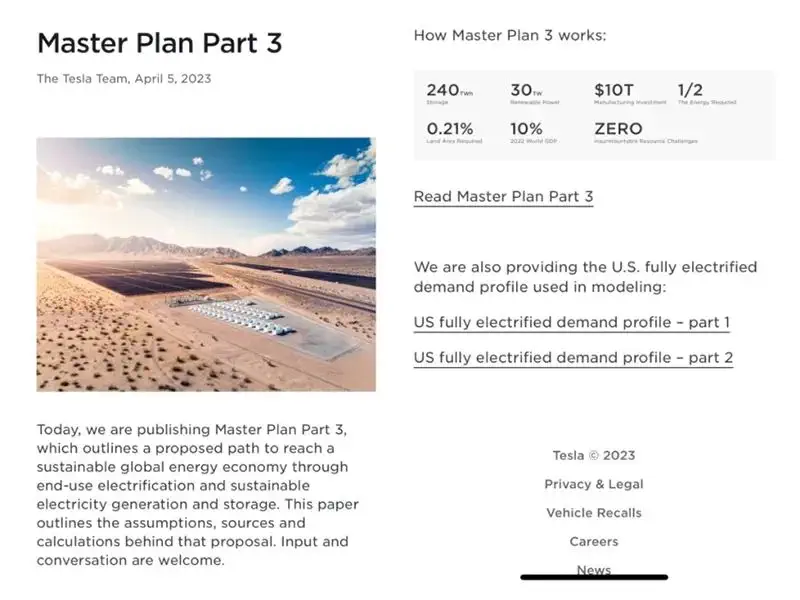LiFePO4 Batteries Star in Tesla’s Budget Car
Tesla had released the full document of its “Master Plan Part 3” for sustainable energy development on April 5th local time. Notably, the full document mentions that Tesla’s small electric vehicles will be equipped with 53kWh lithium iron phosphate batteries, while the Model 3 and Model Y all-electric models will be equipped with 75kWh lithium iron phosphate batteries. Prior to this, Tesla’s US stock had experienced significant declines for three consecutive days. Industry experts pointed out to the Shanghai Securities News reporter that Tesla founder Elon Musk has ambitious goals, and once Tesla’s small, affordable electric vehicles are launched, they will have a huge impact on the new energy vehicle market.
1. Musk’s “Master Plan” Complete, $10 Trillion to Change the Earth
Tesla released the full 41-page document of its sustainable energy development “Master Plan Part 3” on April 5th local time. On March 1, 2023, Musk announced this plan during the first investor day event.
The latest full document reaffirms the goal of achieving a sustainable energy economy. Musk introduced the third chapter of Tesla’s Master Plan, with five steps to achieve the target: 240 TWh of energy storage, 30 TWh of renewable electricity, $10 trillion in manufacturing investments, energy requirements less than half of fuel economy, 0.2% land area for renewable energy production facilities, and energy storage resources reaching 10% of the world’s GDP in 2022.
Industry experts point out that more than a decade ago, Musk had already announced the first and second chapters of his secret master plan.
The 2006 Master Plan Chapter 1 consisted of four steps: 1) produce sports cars; 2) use the money earned to produce affordable cars; 3) use the money earned again to produce even more affordable cars; and 4) provide zero-emission electricity generation options while accomplishing the above tasks.
The 2016 Master Plan Chapter 2 also consisted of four steps: 1) create amazingly efficient, integrated energy storage, and aesthetically pleasing solar panels; 2) expand the electric vehicle product line to meet the needs of various market segments; 3) develop self-driving technology that is ten times safer than human manual driving through large-scale fleet learning; and 4) generate revenue by sharing idle vehicles.
Industry experts say that, looking at the previous chapters of the Master Plan, Tesla has already completed some steps and done them well. However, Tesla’s self-driving plan and other steps have not progressed as planned, and whether the third chapter can be realized remains to be seen.
2. Shanghai Gigafactory expected to undertake Tesla’s low-cost electric vehicle production with LiFePO4 Batteries
In addition to the grand vision of achieving a sustainable energy economy, the full document specifically mentions that Tesla’s small electric vehicles will be equipped with 53kWh lithium iron phosphate batteries, and Model 3 and Model Y all-electric models will be equipped with 75kWh lithium iron phosphate batteries. This further substantiates the previously highly anticipated prediction of Tesla’s low-cost electric vehicles.
The full document states that vehicles with standard range can use lower energy density chemicals (lithium iron phosphate), while long-range vehicles require higher energy density chemicals (high nickel). Compact electric vehicles (undecided Tesla model) will be equipped with 53kWh lithium iron phosphate batteries, with a sales target of 42 million units. Midsize vehicles (such as Tesla Model 3/Y) will be equipped with 75kWh lithium iron phosphate batteries, with a sales target of 24 million units. Large sedans, SUVs, and trucks (such as Tesla Model S/X and Cybertruck electric pickup) will be equipped with 100kWh high-nickel batteries, with a sales target of 9 million units. Long-range heavy-duty trucks (such as Tesla Semi) will be equipped with 800kWh high-nickel batteries, with a sales target of 2 million units.
It was previously reported that Tesla was planning a massive production capacity map for its new low-cost model, building an annual production plan of up to 4 million units. Of these, the North American Gigafactory will handle 2 million units, while the German Berlin factory and the Shanghai Gigafactory in Lingang will each handle 1 million units. In the North American factory, the new Montelery plant in Mexico will be the main production force for this new model.
Tesla has just announced a record-breaking number of new vehicle deliveries for the first quarter of 2023. Data shows that Tesla produced 440,800 vehicles in the first quarter and delivered 422,900 vehicles. Compared to the fourth quarter of 2022, the first quarter of 2023 saw a 4% increase in deliveries; year-on-year, deliveries increased by 36%.
Of these, 19,437 Model S and Model X vehicles were produced, with 10,695 units delivered; 421,400 Model 3 and Model Y vehicles were produced, with 412,200 units delivered. This marks the second consecutive quarter where Tesla’s production and deliveries exceeded 400,000 units. However, some investment institutions believe that Tesla’s first-quarter market performance is related to its aggressive global price reduction strategy, which did not meet external expectations.
On April 5th, Eastern Time, Tesla (TSLA) closed down 3.67% at $185.52, with a market value of $587 billion. The stock has been in decline for three consecutive days, with a cumulative drop of more than 10%, and a market value evaporated of $69.6 billion in three days.
In the highly competitive new energy market, Musk’s electric vehicle goals are ambitious. Once Tesla’s small, affordable electric vehicles are launched, they will have a huge impact on the new energy vehicle market. Musk aims not only for the Chinese new energy vehicle market but also to capture more market shares in other countries. From a product level perspective, he wants to cover and expand the market share of new energy vehicles in different price segments, helping to boost Tesla’s performance and achieve even more ambitious goals.



